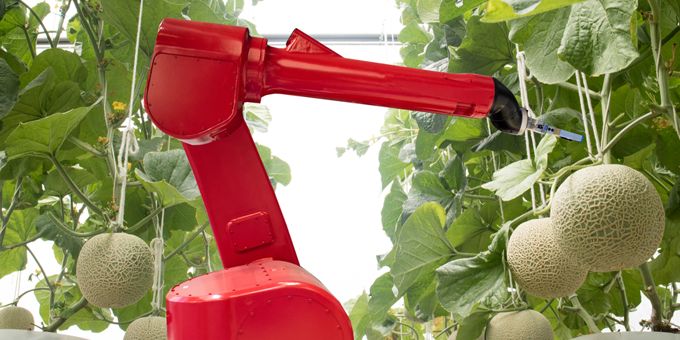A wide range of technologies can enable the transition of agricultural robots into the field. Some technologies will need to be developed specifically for agriculture, while other technologies already developed for other areas could be adapted to the agricultural domain.
 Robotics in Agriculture: an Alternative to Traditional Farming
Robotics in Agriculture: an Alternative to Traditional Farming

Article from | Joylore
Across the globe, farmers are increasingly under pressure to feed the rising global population. Factors like population growth, climate change, political pressure affecting migration, population drift from rural to urban regions, and the demographics of an aging global population are affecting the global food chain. World governments recognize these challenges, and a new generation of smart, flexible, robust, compliant, interconnected robotics and autonomous systems are working seamlessly alongside their human co-workers in farm and food factories.
Agricultural scientists, farmers, and growers are also facing the challenge of producing more food from less land in a sustainable way to meet the demands of an estimated population size of 9.8 billion in 2050. Robotics and Autonomous Systems (RAS) are set to transform many global industries. These technologies could have the most significant impact on large sectors of the economy with relatively low productivity, such as Agri-Food.
Moreover, along with delivering economic benefits, such as increasing productivity and reducing waste throughout the food supply chain, developing a new focus for RAS within Agri-Food can have significant societal and environmental impact. For example, the food chain uses 18% of UK energy consumption, while high mass farm machinery is causing unsustainable compaction damage to our soils; meanwhile, many species of wildlife face risk of extinction due to modern farming practices, including widespread use of herbicides and pesticides, industrialisation of machinery, and reduction in hedgerows and drainage due to increasing field sizes.
A wide range of technologies can enable the transition of agricultural robots into the field. Some technologies will need to be developed specifically for agriculture, while other technologies already developed for other areas could be adapted to the agricultural domain, for example, autonomous vehicles, artificial intelligence, and machine vision. Joylore briefly reviews the current status, opportunities, and benefits of various enabling technologies, from hardware to software, multi-robot systems, and human-robot systems.
Agricultural platforms can be divided into task-specific robots designed to perform a particular task on a given crop in a pre-defined domain, and generic platforms designed to perform several tasks in different domains. Both are likely to play essential roles. Since farms, in general, have a very different infrastructure, early robots may be able to operate only on a given farm and only to a limited extent across different farms. As with the current farm vehicles, we may see a combination of robots adapted to a specific task, and the emergence of multi-purpose robots used to carry out a multitude of different tasks, analogous to the myriad use cases of the modern tractor. A common challenge is that most robotic platforms are not robust to real-world conditions such as mud, rain, fog, low and high temperatures. For example, most current manipulators are not equipped to deal with humidity in glasshouses.
Agricultural robots will require to function in rough terrains. Field robots need to travel on inhomogeneous, uneven, muddy soil, while aerial vehicles need to function for an extended period of time, in different weather conditions. Present robots function by borrowing technology from other sectors like drones or as an add-on to existing platforms.
The true potential of robotics in agriculture can be harnessed when different types of robots and autonomous systems are brought together in a systemic approach. Planning, scheduling, and coordination are fundamental to the control of multi-robot systems on the farm, and generally, for increasing the level of automation in agriculture and farming. For example, intelligent irrigation systems can respond to the change of weather conditions and crop growth status to automatically optimize the irrigation strategy to reduce the use of freshwater without loss of yields. The optimized strategy (e.g., when, where, and the amount of water) is then implemented by computer-controlled irrigation equipment.
Artificial intelligence technologies, especially in machine learning, are expected to play a major role in most of the above technology areas and can be essential enablers for agricultural robots. Agricultural environments are subject to changes throughout the lifetime of a robotic system. For example, there may be new crop varieties, weeds, pests, diseases, treatments, legislation, climate change, etc., as well as new implements and robotic technologies.
If you like this article you may like "The Age of Autonomy: Robotic Solutions for the Horticulture Industry"
The content & opinions in this article are the author’s and do not necessarily represent the views of AgriTechTomorrow
Comments (0)
This post does not have any comments. Be the first to leave a comment below.
Featured Product

